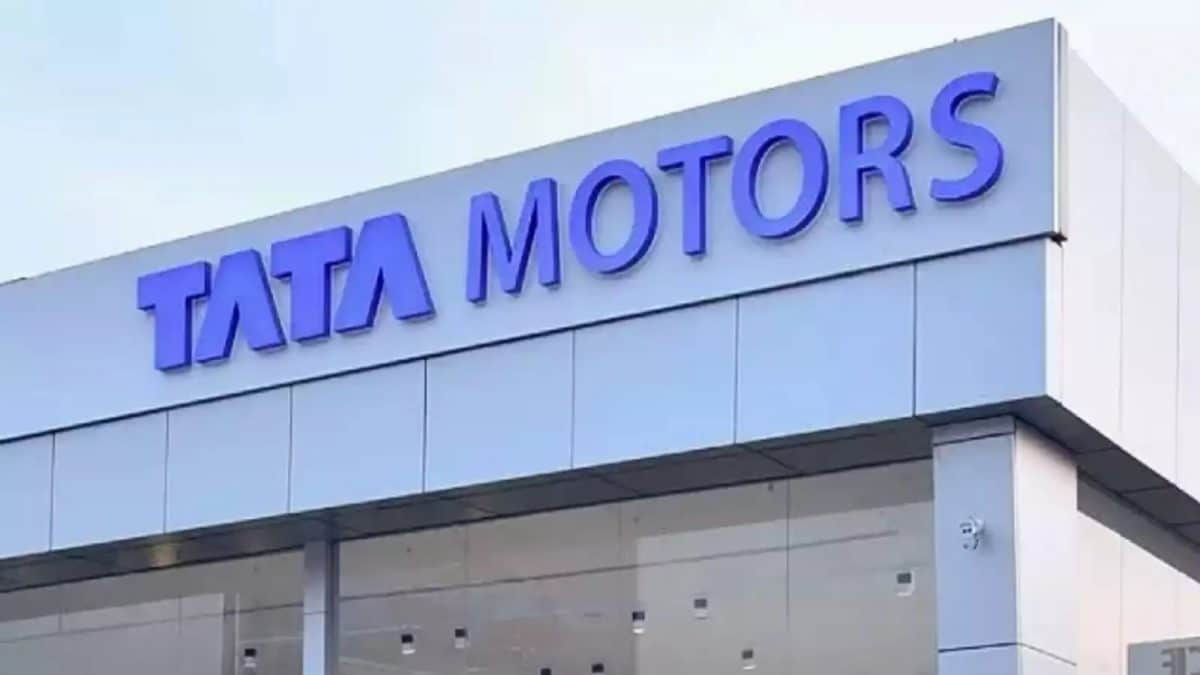Business
Tata Motors, Maruti, Ashok Leyland, Hero: In Auto Stocks Rally, Optimism Over PM Modi’s GST Move

Last Updated:
Shares of auto majors, including Hero MotoCorp, Maruti Suzuki India, Ashok Leyland, TVS Motor and Bajaj Auto, rally 5-8% amid expectations of a GST rate cut.

Tata Motors rose nearly 3% on Monday.
The domestic equity market surged on Monday following Prime Minister Narendra Modi’s announcement on GST reforms, S&P Global’s rating upgrade on India, and other positive global cues. While the benchmark indices, the BSE Sensex and the NSE Nifty, are up by over 1.3% each, the automobile stocks are fuelling the rally the most, with the Nifty Auto Index trading higher by an impressive 4.5%.
Shares of auto majors, including Hero MotoCorp, Maruti Suzuki India, Ashok Leyland, TVS Motor and Bajaj Auto, rallied 5-8% on Monday morning amid expectations that the GST rate on vehicles could be reduced from 28% to 18%.
Maruti Suzuki on August 18 hit its all-time high of Rs 14,048 apiece on the NSE, which is up nearly 8.7% compared with the previous close. Ashok Leyland was up by 7.7% at Rs 131.25, Hero MotoCorp was trading higher by 6.7% at Rs 5,024, TVS Motor Company rose 6.8% to Rs 3,226.8, Hyundai Motor India surged by 8.39% to Rs 2,428 apiece on the NSE.
Tata Motors also rose nearly 3% on Monday to Rs 685 in morning, while Mahindra & Mahindra was up by 4.5% at Rs 3,412. Bajaj Auto was trading higher by 3.7% at Rs 8,521.
Prime Minister Narendra Modi in his Independence Day Speech during the weekend announced a major overhaul in the Goods and Services Tax (GST) structure. Though he did not announce any details, reports said the Centre is considering scrapping the current 12% and 28% GST slabs, realigning most items into the 5% and 18% categories. Certain sin or luxury goods may be placed in a new 40% bracket.
The Centre is reportedly expected to lower the GST on passenger vehicles (PVs) and two-wheelers, enhancing their affordability quotient. Currently, two-wheelers are taxed at 28%. Analysts believe a cut to 18% is highly probable.
Brokerage Notes
Global brokerage firm Jefferies in its note said, “All the listed 2W OEMs – Bajaj, Hero, TVS, and Eicher – should benefit from this cut. We see a low probability of differential GST between entry-level and premium 2Ws.”
In passenger vehicles, small cars currently face an effective tax of 29-31% including compensation cess, making Maruti Suzuki one of the biggest potential beneficiaries of a rate cut. SUVs, however, are taxed at 45-50%, a rate Jefferies said is unlikely to change.
“Hybrid vehicles attract a similar GST rate as ICE vehicles, compared with 5% for EVs. Any reduction in GST on hybrids could be positive for Maruti,” the brokerage added.
Commercial vehicles, also taxed at 28%, may see a reduction to 18%. Ashok Leyland, along with Tata Motors and Eicher Motors, would be key gainers in such a scenario, Jefferies said.
Domestic brokerage firm Motilal Oswal Financial Services in its report on August 18 said automobiles will be one of the key segments that stand to benefit from GST rationalisation.
Passenger vehicle makers Maruti Suzuki and Tata Motors, currently paying 28% GST, are expected to benefit significantly if rates are lowered to 18%. Commercial vehicle maker Ashok Leyland may also see demand tailwinds as GST on trucks and buses comes down to 18% from the current 28%, said Motilal Oswal in the report.
Arun Agarwal, vice-president (fundamental research) of Kotak Securities, said, “The potential GST cuts for the automotive products to 18% would lower on-road prices across segments. We believe lower prices would stimulate demand recovery, and the impact would be more in the mass-market segment. Auto manufacturers (OEM) would gain from higher revenue and potentially higher margin, resulting in possible earnings upgrade.”
Auto ancillaries would also gain from the potential GST cut. However, the impact would vary depending on geographical exposure. Auto ancillary companies having higher revenue exposure in the domestic market stands to benefit more, whereas the gains for global suppliers would be lower given higher export exposure and tariff-related uncertainty, he added.
The government is reportedly planning to propose a simplified two-slab GST structure of 5% and 18%, replacing the current four-tier system of 5%, 12%, 18% and 28%.

Haris is Deputy News Editor (Business) at news18.com. He writes on various issues related to personal finance, markets, economy and companies. Having over a decade of experience in financial journalism, Haris h…Read More
Haris is Deputy News Editor (Business) at news18.com. He writes on various issues related to personal finance, markets, economy and companies. Having over a decade of experience in financial journalism, Haris h… Read More
view comments
Read More
Business
Gross GST collections for November stand at over Rs 1.70 lakh crore; up 0.7 per cent – The Times of India

GST collections: The Gross Goods and Services Tax (GST) collections for the month of November came in at over Rs 1.70 lakh crore. This is a rise of 0.7%, according to official data.SBI Research in a report in November had estimated that the gross domestic GST collections may come around Rs 1.49 lakh crore for November 25 (returns of October 25 but filed in Nov’25), a YoY growth of 6.8%.“Coupled with Rs 51,000 crore of IGST and cess on Import, the November GST collections thus could cross Rs 2.0 lakh crore, driven by the peak festive season demand led by lower GST rate and increased compliance while most of states experience positive gains,” SBI Research had said.This story is being updated
Business
Key Financial Deadlines That Have Been Extended For December 2025; Know The Last Date

New Delhi: Several crucial deadlines have been extended in December 2025, including ITR for tax audit cases, ITR filing and PAN and Aadhaar linking. These deadlines will be crucial in ensuring that your financial affairs operate smoothly in the months ahead.
Here is a quick rundown of the important deadlines for December to help you stay compliant and avoid last-minute hassles.
ITR deadline for tax audit cases
The Central Board of Direct Taxes has extended the due date of furnishing of return of income under sub-Section (1) of Section 139 of the Act for the Assessment Year 2025-26 which is October 31, 2025 in the case of assessees referred in clause (a) of Explanation 2 to sub-Section (1) of Section 139 of the Act, to December 10, 2025.
Belated ITR filing deadline
A belated ITR filing happens when an ITR is submitted after the original due date which is permitted by Section 139(4) of the Income Tax Act. Filing a belated return helps you meet your tax obligations, but it involves penalties. You can only file a belated return for FY 2024–25 until December 31, 2025. However, there will be a late fee and interest charged.
PAN and Aadhaar linking deadline
The Income Tax Department has extended the deadline to link their PAN with Aadhaar card to December 31, 2025 for anyone who acquired their PAN using an Aadhaar enrolment ID before October 1, 2024. If you miss this deadline your PAN will become inoperative which will have an impact on your banking transactions, income tax return filing and other financial investments.
Business
Stock Market Live Updates: Sensex, Nifty Hit Record Highs; Bank Nifty Climbs 60,000 For The First Time

Stock Market News Live Updates: Indian equity benchmarks opened with a strong gap-up on Monday, December 1, touching fresh record highs, buoyed by a sharp acceleration in Q2FY26 GDP growth to a six-quarter peak of 8.2%. Positive cues from Asian markets further lifted investor sentiment.
The BSE Sensex was trading at 85,994, up 288 points or 0.34%, after touching an all-time high of 86,159 in early deals. The Nifty 50 stood at 26,290, higher by 87 points or 0.33%, after scaling a record intraday high of 26,325.8.
Broader markets also saw gains, with the Midcap index rising 0.27% and the Smallcap index advancing 0.52%.
On the sectoral front, the Nifty Bank hit a historic milestone by crossing the 60,000 mark for the first time, gaining 0.4% to touch a fresh peak of 60,114.05.
Meanwhile, the Metal and PSU Bank indices climbed 0.8% each in early trade.
Global cues
Asia-Pacific markets were mostly lower on Monday as traders assessed fresh Chinese manufacturing data and increasingly priced in the likelihood of a US Federal Reserve rate cut later this month.
According to the CME FedWatch Tool, markets are now assigning an 87.4 per cent probability to a rate cut at the Fed’s December 10 meeting.
China’s factory activity unexpectedly slipped back into contraction in November, with the RatingDog China General Manufacturing PMI by S&P Global easing to 49.9, below expectations of 50.5, as weak domestic demand persisted.
Japan’s Nikkei 225 slipped 1.6 per cent, while the broader Topix declined 0.86 per cent. In South Korea, the Kospi dropped 0.30 per cent and Australia’s S&P/ASX 200 was down 0.31 per cent.
US stock futures were steady in early Asian trade after a positive week on Wall Street. On Friday, in a shortened post-Thanksgiving session, the Nasdaq Composite climbed 0.65 per cent to 23,365.69, its fifth consecutive day of gains.
The S&P 500 rose 0.54 per cent to 6,849.09, while the Dow Jones Industrial Average added 289.30 points, or 0.61 per cent, to close at 47,716.42.
-

 Sports1 week ago
Sports1 week agoWATCH: Ronaldo scores spectacular bicycle kick
-

 Entertainment1 week ago
Entertainment1 week agoWelcome to Derry’ episode 5 delivers shocking twist
-

 Politics1 week ago
Politics1 week agoWashington and Kyiv Stress Any Peace Deal Must Fully Respect Ukraine’s Sovereignty
-

 Business1 week ago
Business1 week agoKey economic data and trends that will shape Rachel Reeves’ Budget
-

 Tech6 days ago
Tech6 days agoWake Up—the Best Black Friday Mattress Sales Are Here
-

 Politics1 week ago
Politics1 week ago53,000 Sikhs vote in Ottawa Khalistan Referendum amid Carney-Modi trade talks scrutiny
-

 Fashion1 week ago
Fashion1 week agoCanada’s Lululemon unveils team Canada kit for Milano Cortina 2026
-

 Tech6 days ago
Tech6 days agoThe Alienware Aurora Gaming Desktop Punches Above Its Weight





